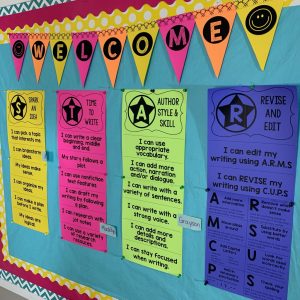What is a student writing goal board?

A student writing goal board is a visual guide that helps students keep track of their individual goals for a particular subject area.
On and off, I have used the goal board in my classroom. I started using student writing goal boards with Daily 5 and Cafe but quickly realized that what they presented just didn’t fit my teaching style. It was like working a square peg into a round hole. It was good but just not right.
I have had student groups that have used it and student groups that have not.
As I move through the year with my students, I realize that setting clear goals and making paths to achieve these goals will be paramount to helping them achieve success.
So a student writing goal board now features prominently in my classroom and is a key feature of the Ignited Literacy program.
Where are student writing goal boards used?
Student writing goal boards can be used in any subject matter, but I do think that it is essential to start small and stick with one subject area. This can then be moved into other curriculum areas as students are ready and get the hang of the process.
Student writing goal boards are a massive focus on student voice and choice in my classroom and an area where students can take on more ownership of their learning. We have conferenced many times about their previous writing samples, so they know where they need to go and what they need to do.
Why a student writing goal board, then?
Well, the specific purpose of this is to make learning visible and to have a visual board that serves to hold students accountable and keep students organized.
If you have students that are
- visual learners
- struggle with organization
- have executive functioning difficulties
- struggle to respond to feedback to make improvements
- want more autonomy and control over their learning
If you, as a teacher, want
- your students to keep track of their learning
- students to be responsible for their learning and progress
- a simple visual way to track students (status of the class)
- to show student voice and choice in your classroom
- to not be the only one monitoring all the data in your classroom
Yep, that is exactly what I want and need. You?
What do you need to get started?

Use this paper to brighten up your space.
Finally, add student questions to your Wonderwall with sticky notes. These can quickly move and adjust as student questions change. Use various colours of sticky notes to indicate different questions or comments.
1st, Choose your subject area.
I have picked writing as an excellent place to start.
Now, look at different categories students can work on within this subject area.
Math: Solving Problems, Choosing Strategies, Computational. If you follow the Ontario curriculum using the process expectations, here would be great categories to follow. They could be combined and reduced to 4-5 categories as goal areas. Alternatively, you could select the four most needed areas for students to focus on.
Science and Social Studies: Look at the overall expectations of your curriculum or the big ideas. These will be significant goal areas or areas to focus on for a goal board. Alternatively, you could use the achievement chart categories, including Knowledge and Understanding, Thinking, Communication, and Application.
Language: You can look at writing goals, such as breaking the writing process into sections and having students focus on one area specifically. You can look at areas such as fluency, decoding, and comprehension for reading.
Use I Can Statements
For each student writing goal board category, you will want to put them in student-friendly language.
Using I can statement to frame your specific goals will help to make these relevant to your students.
Think like students and try to avoid teacher-speak. Unless you have made teachers’ phrases part of the language of your classroom, then you should avoid putting these on the goal cards.
Track Student Progress
So you post the student writing goal board, and students look at it once and never again…
This is what I try to avoid. If I am putting it up, I want it to be used because I feel it will be valuable.
So how do I do that?
It starts with routine. For a while, I will conference bi-weekly with students on their writing. Before they conference with me, they fill out a feedback form. This form asks them for their goal. So in part, they have been making goals all along. But this hasn’t been a focus.
With the goal board, we will physically identify which goal they are working on. We use a marker, like a sticky note, magnet, etc., with the student’s name. This name card will go next to the goal that the student is working on. If you lack horizontal space, this can also be done by putting an area below your goal cards for students to put their names. This will signal which goal areas they focus on instead of the individual goal card.
Ready to make your own?
Are you ready to try a goal board in your classroom?
If you want to try the pre-made one I have for my Ignited Literacy Language Program, you can find that here
: https://madlylearning.com/goalboar.d.